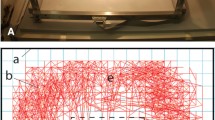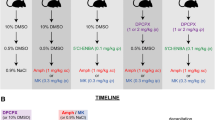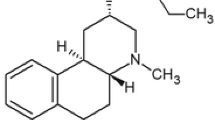Abstract
The effect of various psychotropic drugs on the ambivalent behaviour “stretched approach posture” (SAP) in the rat was assessed. SAP was elicited after a mild startle reaction due to physical contact with an electrified prod at one end of a straight runway. Using ethological observation methods, SAP as well as intention movements, prod contact, crossings, rearing, exploration, grooming and immobility were recorded. The benzodiazepine receptor agonists chlordiazepoxide, diazepam and alprazolam, the 5-HT1A receptor agonists flesinoxan and ipsapirone and the 5-HT uptake inhibitor clomipramine selectively (no effect on crossings) reduced SAP. Except for alprazolam, these drugs also reduced intention movements. In addition, chlordiazepoxide and diazepam enhanced prod contact. Reductions of SAP and intentions with concomitant reductions of crossings (nonspecific anti-ambivalent effects) were established for the α2-adrenoceptor agonist clonidine and the MAO inhibitor clorgyline. The 5-HT uptake inhibitor fluvoxamine suppressed intention movements, but not SAP. The mixed 5-HT/NA uptake inhibitor imipramine did not significantly affect SAP or intentions, but reduced crossings. The 5-HT2C/1B receptor agonist m-CPP, the inverse BZD receptor agonists FG 7142 and DMCM, and the α2-adrenoceptor antagonist yohimbine, to all of which putative anxiogenic effects have been ascribed, had no effect on SAP directed towards the prod. m-CPP, however, produced an increase in the stretched posture directed away from the prod (SAwayP). FG 7142 reduced intentions while strongly enhancing immobility (freezing). SAwayP and/or freezing may possibly reflect anxiogenic properties of drugs. The putative anxiogenic drug pentylenetetrazol false positively reduced SAP while increasing exploration. The dopamine-D2 receptor antagonist haloperidol and the catecholamine releaserdl-amphetamine had no effect on ambivalent behaviour. The muscarine receptor antagonist scopolamine reduced SAP and intentions while stimulating crossings. Finally, the 5-HT2C receptor antagonist ritanserine, the CCKA receptor antagonist devazepide, the CCKB receptor antagonist L-365.260 and the strychnine-insensitive glycine site antagonist 7-Cl-kynurenic acid were without effect on the behaviours in this paradigm using single doses. In conclusion, SAP and intention movements were reduced selectively by anxiolytic agents from different classes, including benzodiazepine receptor agonists, 5-HT1A receptor agonists and a 5-HT uptake inhibitor, whereas an α2-adrenoceptor agonist and a MAO inhibitor reduced SAP non-selectively. SAP in relation to other behaviours may therefore serve as a valuable paradigm to characterize anxiolytic drugs.
Similar content being viewed by others
References
Andrew RJ (1956) Some remarks on behaviour in conflict situations, with special reference toEmberiza spp. Br J Anim Behav 4:41–45
Bindra D (1961) Components of general activity and the analysis of behavior. Psychol Rev 68:205–215
Blanchard RJ, Blanchard DC, Weiss SM, Meyer S (1990) The effects of ethanol and diazepam on reactions to predatory odors. Pharmacol Biochem Behav 35:775–780
Boyer WF, Feighner JP (1993) A placebo-controlled double-blind multicentre trial of two doses of ipsapirone versus diazepam in generalized anxiety disorder. int Clin Psychopharmacol 8:173–176
Bradford LD, The German Anxiety Research Group (1993) Flesinoxan treatment of generalized anxiety disorder: a fixed dose, placebo controlled study. J Psychopharmacol [suppl] A65
Ceulemans DLS, Hoppenbrouwers M-LJA, Gelders YG, Reyntjens AJM (1985) The influence of ritanserin, a serotonin antagonist, in anxiety disorders: a double-blind placebo-controlled study versus lorazepam. Pharmacopsychiatry 18:303–305
Charney DS, Heninger GR, Breier A (1984) Noradrenergic functioning in panic anxiety: effects of yohimbine in healthy subjects and patients with agoraphobia and panic disorder. Arch Gen Psychiatry 41:751–763
Chouinard G, Annable L, Fontaine R, Solyon L (1982) Alprazolam in the treatment of generalized anxiety and panic disorders: a double-blind, placebo-controlled study. Psychopharmacology 77:229–233
Claus H-J, Bindra D (1960) Reactions to novelty and stimulus-change induced response decrement. Can J Psychol 14:101–110
Cole JC, Rodgers RJ (1993) An ethological analysis of the effects of chlordiazepoxide and bretazenil (Ro 16-6028) in the murine elevated plus-maze. Behav Pharmacol 4:573–580
Cole JC, Rodgers RJ (1994) Ethological evaluation of the effects of acute and chronic buspirone treatment in the murine elevated plus-maze test: comparison with haloperidol. Psychopharmacology 114:288–296
Corda MG, Costa E, Guidotti A (1983) Involvement of GABA in the facilitation of punishment suppressed behavior induced byβ-carbolines in rat. In: Biggio G, Costa E (eds) Advances in biochemical psychopharmacology, vol. 38. Benzodiazepine recognition site ligands: biochemistry and pharmacology. Raven Press New York, p 121
Cutler MG, Dixon AK (1988) Effects of ipsapirone on the behaviour of mice during social encounters. Neuropharmacology 27:1039–1044
Daanje A (1950) On locomotory movements in birds and the intention movements derived from them. Behaviour 3:48–98
De Boer SF, Slangen JL, Van der Gugten J (1990) Plasma catecholamine and corticosterone levels during active and passive shock-prod avoidance behavior in rats: effects of chlordiazepoxide. Physiol Behav 47:1089–1098
Den Boer JA, Westenberg HGM, Kamerbeek WDJ, Verhoeven WMA, Kahn RS (1987) Effect of serotonin uptake inhibitors in anxiety disorders: a double blind comparison of clomipramine with fluvoxamine. Int Clin Psychopharmacol 2:21–32
Drew GM, Gower AJ, Marriott AS (1979) α2-Adrenoceptors mediate clonidine-induced sedation in the rat. Br J Pharmacol 67:133–141
File SE, Pellow S (1984) The anxiogenic effect of FG 7142 in the social interaction test is reversed by chlordiazepoxide and Ro15-1788 but not CGS 8216. Arch Int Pharmacodyn Ther 271:198–205
Garbe CM, Kemble ED, Rawleigh JM (1993) Novel odors evoke risk assessment and suppress appetitive behaviors in mice. Aggress Behav 19:447–454
Grant EC, Mackintosh JH (1963) A comparison of the social post-ures of some common laboratory rodents. Behaviour 21:246–259
Hendrie CA, Neill JC, Shepherd JK, Dourish CT (1993) The effects of CCKA and CCKB antagonists on activity in the black-white exploration model of anxiety in mice. Physiol Behav 54:689–693
Hill TJ, Fontana DJ, McClosky TC, Commissaris RL (1992) Betacarboline and pentylenetetrazol effects on conflict behavior in the rat. Pharmacol Biochem Behav 42:733–736
Hinde RA (1970) Behaviour on conflict situations. In: Hinde RA (ed) Animal behaviour. a synthesis of ethology and comparative psychology. McGraw-Hill, New York, pp 270–290
Hoehn-Saric R, Merchant AF, Keyser ML, Smith VK (1981) Effects of clonidine on anxiety disorders. Arch Gen Psychiatry 38:1278–1282
Jenike MA, Hyman S, Baer L, Holland A, Minichiello WE, Buttolph L, Summergrad P, Seymour R, Ricciardi J (1990) A controlled trial of fluvoxamine in obsessive-compulsive disorder: implications for a serotonergic theory. Am J Psychiatry 147:1209–1215
Kaesermann HP (1986) Stretched attend posture, a non-social form of ambivalence, is sensitive to a conflict-reducing drug action. Psychopharmacology 89:31–37
Kaesermann HP, Dixon AK (1986) Further validation of the SAP test, a simple behavioral conflict test in mice. Psychopharmacology 89:S19
Kennett GA (1992) 5-HT1C receptor antagonists have anxiolytic-like actions in the rat social interaction model. Psychopharmacology 107:379–384
Kennett GA, Whitton P, Shah K, Curzon G (1989) Anxiogenic-like effects of mCPP and TFMPP in animal models are opposed by 5-HT1C receptor antagonists. Eur J Pharmacol 164:445–454
McTavish D, Benfield P (1990) Clomipramine: an overview of its pharmacological properties and a review of its therapeutic use in obsessive compulsive disorder and panic disorder. Drugs 39:136–153
Meert TF, Colpaert FC (1986) The shock probe conflict procedure. A new assay responsive to benzodiazepines, barbiturates and related compounds. Psychopharmacology 88:445–450
Moran PM (1993) Differential effects of scopolamine and mecamyline on working and reference memory in the rat. Pharmacol Biochem Behav 45:533–538
Morris D (1957) The reproductive behaviour of the Bronze Mannikin (Lonchura cucullata). Behaviour 11:156–201
Murphy DL, Mueller EA, Hill JL, Tolliver TJ, Jacobsen FM (1989) Comparative anxiogenic, neuroendocrine and other physiologic effects ofm-chlorophenylpiperazine given intravenously or orally to healthy volunteers. Psychopharmacology 98:275–282
Petersen EN, Jensen LH (1984) Proconflict effect of benzodiazepine receptor inverse agonists and other inhibitors of GABA function. Eur J Pharmacol 103:91–97
Pinel JPJ, Mana MJ, Ward JAA (1989) Stretched-approach sequences directed at a localized shock source byRattus norvegicus. J Comp Psychol 103:140–148
Pollard GT, Howard JL (1988) Effects of chlordiazepoxide, pentobarbital, buspirone, chlorpromazine and morphine in the stretched attend posture (SAP) test. Psychopharmacology 94:433–434
Rickels K, Downing R, Schweizer E, Hassman H (1993) Antidepressants for the treatment of generalized anxiety disorder — a placebo-controlled comparison of imipramine, trazodone and diazepam. Arch Gen Psychiatry 50:884–895
Rigby WK (1954) Approach and avoidance gradients and conflict behaviour in a predominantly temporal situation. J Comp Physiol Psychol 47:83–89
Sieghart P (1992) GABAA receptors: ligand-gated Cl−-ion channels modulated by multiple drug-binding sites. Trends Pharmacol Sci 13:446–450
Silverman AP (1965) Ethological and statistical analysis of drug effects on the social behavior of laboratory rats. Br J Pharmacol 24:579–580
Treit D (1990) A comparison of anxiolytic and nonanxiolytic agents in the shock-probe/burying test for anxiolytics. Pharmacol Biochem Behav 37:203–205
Treit D, Fundytus M (1988) A comparison of buspirone and chlordiazepoxide in the shock-probe/burying test for anxiolytics. Pharmacol Biochem Behav 30:1071–1075
Treit D, Pinel JPJ, Fibiger HC (1981) Conditioned defensive burying of a shock prod: a new paradigm for the study of anxiolytic agents. Pharmacol Biochem Behav 15:619–626
Tyrer P, Shawcross C (1988) Monoamine oxidase inhibitors in anxiety disorders. J Psychiatry Res 22:87–98
Uhde TW, Stein MB, Vittone BJ, Siever LJ, Boulenger JP, Klein E (1989) Behavioural and physiological effects of short-term and long-term administration of clonidine in panic disorder. Arch Gen Psychiatry 46:170–177
Van der Poel AM (1967) Ethological study of the behaviour of the albino rat in a “passive-avoidance”-test. Acta Physiol Pharmacol Neerl 14:503–504
Van der Poel AM (1979) A note on “stretched attention”, a behavioural element indicative of an approach-avoidance conflict in rats. Anim Behav 27:446–450
Winslow JT, Insel TR, Trullas R, Skolnick P (1990) Rat pup isolation calls are reduced by functional antagonists of the NMDA receptor complex. Eur J Pharmacol 190:11–21
Woodruff GN, Hughes J (1991) Cholecystokinin antagonists. Annu Rev Pharmacol Toxicol 31:469–501
Zitrin CM, Klein DF, Woerner MG (1980) Treatment of agoraphobia with group exposure in vivo and imipramine. Arch Gen Psychiatry 37:63–72
Zohar J, Insel TR (1987) Drug treatment of obsessive-compulsive disorder. J Affect Dis 13:193–202
Author information
Authors and Affiliations
Rights and permissions
About this article
Cite this article
Molewijk, H.E., van der Poel, A.M. & Olivier, B. The ambivalent behaviour “stretched approach posture” in the rat as a paradigm to characterize anxiolytic drugs. Psychopharmacology 121, 81–90 (1995). https://doi.org/10.1007/BF02245594
Received:
Revised:
Issue Date:
DOI: https://doi.org/10.1007/BF02245594




